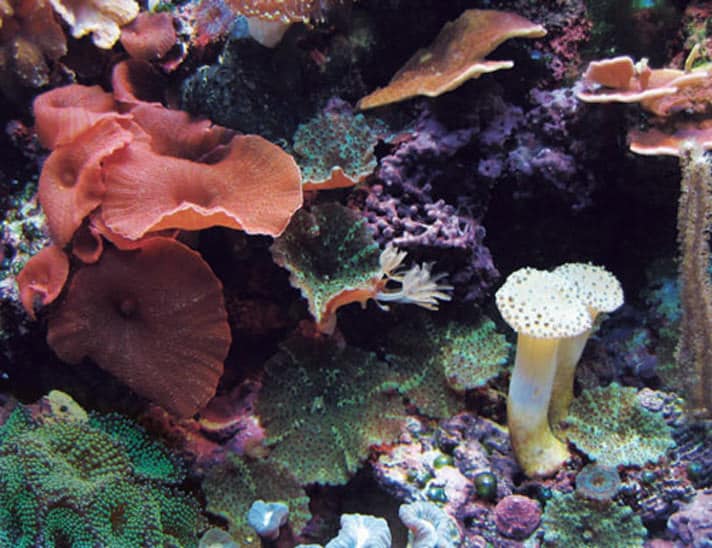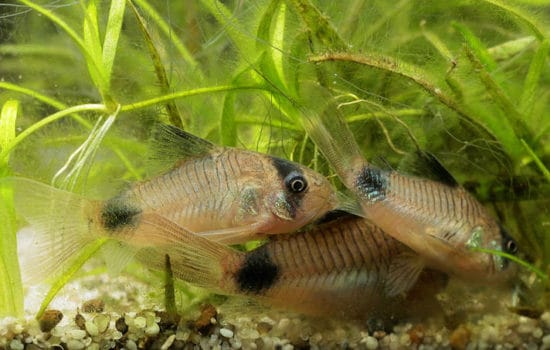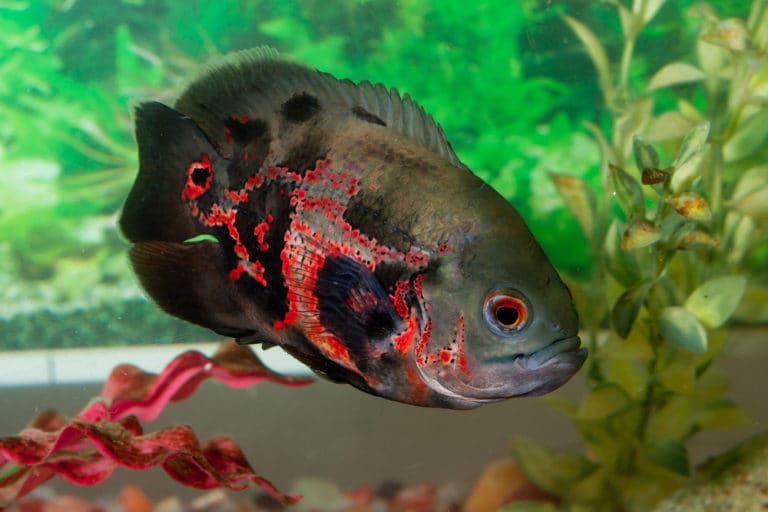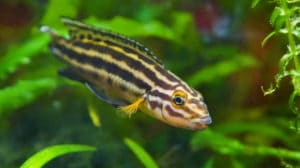Nano-reef aquariums (generally tanks less than 30 gallons) are a lot of fun. The challenges of establishing and maintaining a tiny reef aquarium can be disproportionately large. Other articles have dealt with the equipment and filtration needed to maintain stable conditions within the nano-reef aquarium. Yet there are other challenges facing the nano aquarist beyond what filter and lights to use.
Once your system is established, you will need to stock it. Livestock selection is crucial to the success of small reef tanks. There may be many fish in the sea, but there are quite a few corals, too — and knowing which corals are suitable is vital to the success of your nano-reef. I’ve maintained a number of small reef aquariums through the years. My success or failure was often a product of how I initially stocked them.
Many corals can be kept in a nano-sized reef. When considering corals for your nano-reefs, there are three questions you should ask:
- Will it survive?
- Is it aggressive?
- Will it look natural?
Soft Corals
Leather Corals
These soft branching corals (Sinularia spp.) are the ideal candidates for a nano-reef. Small pieces can be obtained from taking cuttings from your main display or from local aquarists. These fragments (frags) can be pruned to resemble smaller versions of the adult colony — perfect for someone trying to create a miniaturized reef. They can grow quickly but are easy to prune. They do not produce sweeper tentacles that could sting neighboring corals.
Other branching corals include colt (Alcyonium spp.), devil’s hand (Lobophytum spp.) and Kenya tree coral (Capnella spp.). Of these, colt coral is the most difficult to prune (getting new frags to attach can be tricky), and Kenya tree coral is the most delicate. But both can still be good additions to a small tank. Toadstool corals. Sarcophyton are wonderful corals for nano-reefs and are very easy to prune. Simply snip the head off once in a while when the coral gets too large. The remaining stalk will quickly regrow its crown. The severed head can be cut into pie-shaped wedges, and each wedge will grow into a nice nano-sized toadstool.
Mushroom Corals
Some corals, such as Actinodiscus, Rhodactis and Ricordea, are often referred to as mushroom corals. These species are hardy, colorful and often the first corals added to any reef tank. They will spread, and some (especially R. yuma) are aggressive. They are hard to remove when they spread to neighboring rocks.
Elephant ear mushroom is the only type that is blatantly too large for a nano-reef, but I’ve seen many other mushrooms expand to the size of saucers. These large polyps will bring a sense of perspective to the overall size of your tank — not a good thing for a nano. If this “small-tank-with-big-corals” look is not for you, then mushrooms should be selected with care. Ricordea florida may be the best choice for a nano-tank, simply because they do not spread as quickly as other species. Start with one or two polyps to avoid them dominating your tank.
Zoanthids
These hardy, colorful corals have the perfect polyp size for a nano-reef aquarium. Their small size makes them ideal for replicating a miniature reef. They will sting other corals they come into contact with, but they do not produce sweepers. The downside is that their growth is difficult to control. They will spread to neighboring rocks and can be difficult to remove. You can remove the rock, and try to peel and scrape the invading coral; or you may need to use a wire brush to remove the tissue completely. (Be careful with these corals as they possess neurotoxins that can make you sick) Or you can allow the coral to colonize neighboring rocks, and then sell or trade the rocks. This course of action means adding new live rock and aquascaping your tank regularly.
Star Polyps, Anthellia and Xenia
These corals are vigorous, colorful and have a small polyp size — perfect for a nano-reef. They also spread and are difficult to prune back. You have the same options of scrubbing the coral as it invades neighboring rocks, or swapping encrusted rock for sale or trade. With these corals, you can also let them spread from rock to rock until they dominate the entire tank. That’s how fast they grow. A tank covered in metallic green star polyps with a couple small fish would make for a stunning display.
Gorgonians
Photosynthetic gorgonians are more demanding in terms of lighting and flow, but they are still good candidates for nano-reefs. Eunicea, Plexaura, Pseudopterogorgia, Pterogorgia and Muricea are all good options. The “frilly” gorgonians like Psuedopterogorgia and Pterogorgia have a small branching structure that is proportionate with smaller reef tanks. Cuttings of these corals can be pruned to blend in perfectly on your miniaturized reef.
Avoid nonphotosynthetic gorgonians (Diodogorgia spp.). Although these species may look great in a nano-tank, they are difficult to keep alive even in large reef tanks. Meeting their specialized flow and dietary requirements is especially hard in nano-tanks.
Hard Corals
Hammers and Frogspawn
Will these survive? This is the pertinent question with keeping stony corals in small tanks. Fortunately, most Euphyllia are resilient and (with proper attention to water quality) can survive just fine in a nano-reef environment.
The branching varieties are easily pruned, which allows selection of the right-sized specimen and control of future growth. Euphyllia corals are capable of producing sweeper tentacles. Sweepers can be reduced or eliminated by selecting small coral specimens and isolating them enough so that they don’t contact other corals.
Torch coral (Euphyllia glabrescens) is more delicate and not the best choice for a nano-reef.
Brain Corals
Both the “open” and “closed” brain corals are hardy enough to be included in the well-maintained nano-reef. These corals suffer more quickly from neglect and are more difficult to save if their health starts to decline. They are not easily fragmented, and obtaining nano-sized specimens can be a challenge. A small open brain (Trachyphyllia spp.) may look all right in a 20-gallon reef tank, but in anything smaller, it will look out of place. If you really want the look of a brain coral in your nano-reef, obtain a frag of one of the Blastomussa species. While not technically a brain coral, Blastomussa grows into a nice spherical “brain” shape if given adequate space.
Bubble Coral
Bubble corals are vigorous enough to survive in a nano-reef. Like brain corals, they suffer quickly from neglect. Obtaining small specimens is a challenge. The worst knock against bubble corals is their tendency to produce long sweepers, which can wreak havoc in a tiny reef.
Galaxy Coral
This is an attractive coral with relatively small polyps, but the sweeper tentacles this coral produces are long and lethal, making it a poor choice for a nano-reef.
Trumpet Coral
This is an excellent choice for a small tank. Caulastrea is hardy and not aggressive. Its branching structure makes it easy to prune, and frags of this stony coral are often traded among hobbyists.
Montipora
Branching varieties (e.g., Montipora digitata) can be kept in a nano-reef quite successfully. They are hardy, nonaggressive and can be pruned as needed. Foliate or plating Montipora corals are strong. In fact, if you provide adequate water quality, light and water motion, then these corals will grow nicely in your nano. The problem is that a frag of M. capricornis can grow to the size of a dinner plate in a year. It’s a beautiful coral, but it’s not particularly suited to a small tank.
Acropora
Keeping these delicate corals requires dedication and is best left to the fanatics. They can be kept in practically any sized tank. Assuming their needs are met in terms of stable water quality, light and water flow, tank size is immaterial. Meeting these needs in a small tank and providing long-term stability is quite challenging, but it can be done. Aesthetically, creating a natural-looking display using Acropora species in a nano-reef is equally challenging. A fully developed colony of Acropora is a beautiful thing. One drawback is that frags of Acropora look like frags. And they will look like frags until they mature into a colony — at which point they will have likely outgrown your nano. Choosing specimens with a fine branch structure (rather than staghorn-growth forms) and starting with small frags increases the chances of growing out small colonies.
Other Stony Corals
Pocillopora, Stylophora and Seriatopora are excellent choices for hard-core nano-reefkeepers. Small fragments of these corals develop quickly into small, natural-looking colonies. They are a good substitute for Acropora and come in pink, green, brown, blue and other colors.
Conclusion
There is a wide array of corals to consider for nano-reef aquariums. Survivability, aggressiveness, polyp and colony size should be determining factors when considering a specimen. It should look natural in your nano. Keeping nano-reefs is as addicting as regular reefs. Don’t be surprised to find yourself setting up a second or a third nano.
Dan Theisen has been keeping reefs and culturing corals for more than 20 years. He has published more than 20 articles on the subject. He is a stay-home father of three daughters, a writer and an addicted hobbyist.
Feature Image: Courtesy of Dan Theisen
Share:









